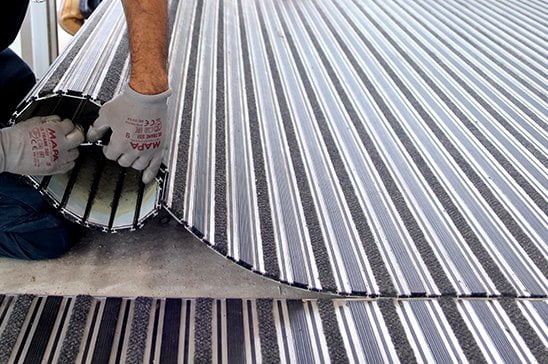There are many ‘slip resistant’ commercial floorcoverings available today. The Health & Safety Executive (HSE) states that slips are the most common type of accident to members of the public, most of which are caused by contaminated floor surfaces. We explain how well specified entrance matting can support the safety performance of slip-resistant flooring.

It would be easy to presume that a floorcovering described as ‘slip resistant’ is unlikely to become slippery. The problem is that’s not the case. Slip resistant products may have undergone a variety of slip tests, such as the widely recognised Pendulum test for example (considered to be the most reliable and the test recognised by the Health and Safety Executive). But it’s important to realise that while these tests are all valid, the floorcovering is only slip resistant in a factory tested environment.
The characteristics (that is, slip resistance) of the floorcovering can change during and after the installation phase, and grinding, polishing and cleaning products can all contribute to this, as can general wear. It is not just finishing and cleaning techniques that affect slip resistance properties either. Contaminants such as the ingress of dirt and moisture from the soles of people’s shoes can make proprietary slip resistant flooring products become slippery in an instant. That is a real danger in any commercial building.
The latter issue of walked-in contaminants is one of the simplest to overcome through the installation of a good quality entrance matting system. A well specified entrance matting system can support the efficacy of a slip resistant floorcovering, thus playing a major role in reducing the risk of slip and fall claims in a built environment.
Dirt contaminants from soles of shoes have two definitive adverse effects on floors:
- They leave particulates on the floorcovering which changes the nature and specification of the floorcovering, and resilient floors are made more slippery.
- They degrade floors quicker due to increased wear of ground-in particulates. In the case of safety flooring/slip resistant flooring, the product becomes less ‘slip resistant’ as the dirt particulates break down the micro roughness of the floor more quickly than if it were clean, supporting the case for ‘prevention rather than cure’.

How does this affect the users of a building?
As a floor becomes more slippery, the likelihood of slip related accidents inevitably becomes greater. Most slip resistant floorcoverings will return a Pendulum Test Value (PTV) of 36, suggesting that the risk of slipping is 1 in 100,000. However, that PTV of 36 is achieved in a factory environment. With contaminants on the floor, this can very quickly drop to 20 PTV, presenting a suggested 1 in 2 risk of slipping. At this point, the building has a serious problem!
Entrance matting can significantly alleviate this problem of walked in contaminants. Well structured entrance matting, that has an adequate walk-off length, captures the dirt and moisture at the entrance, and virtually eliminates any dirt, debris or moisture being tracked any further into the facility. People very rarely stop to wipe their feet in a public building so it’s important to factor in, not just the type of matting (such as aluminium, PVC/carpet) but also the length of matting, and whether the preferred cleaning method works best with an open or closed surface design.
All entrances throw up different challenges for specifiers. Factors such as footfall, type of contaminant, wheeled traffic and location need to be taken into consideration when specifying the correct system for a building. Get the entrance matting specification right though, and it can minimize the risk of litigation. Get it wrong and it can potentially cost a lot of money!
The HSE provides some useful guidance on ‘Assessing the slip resistance of flooring’.
Need help specifying entrance matting, or technical information about any of our aluminium systems or PVC/carpet entrance tiles? Please contact COBA Flooring.







